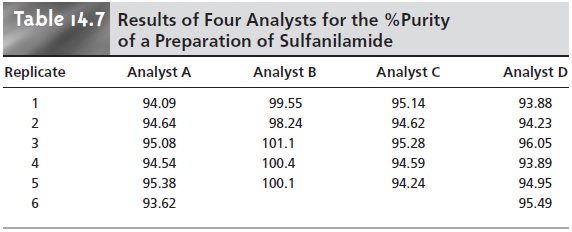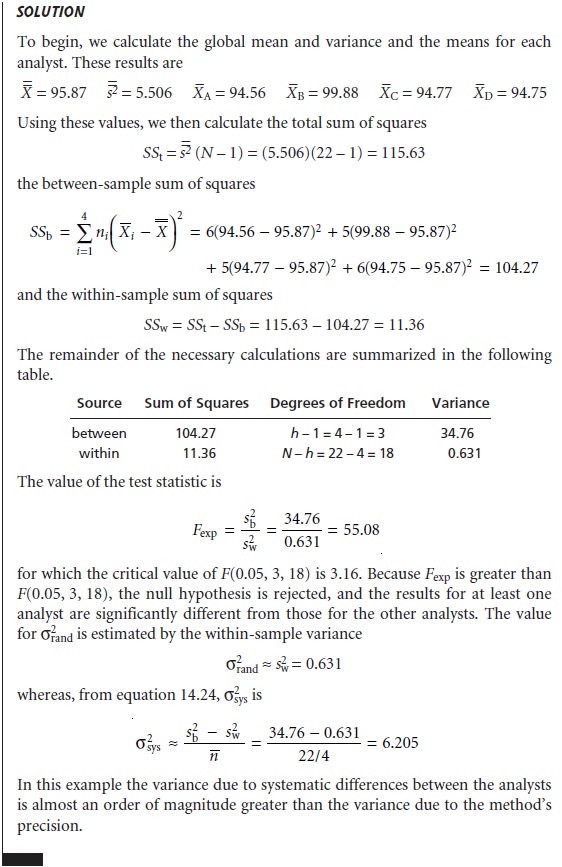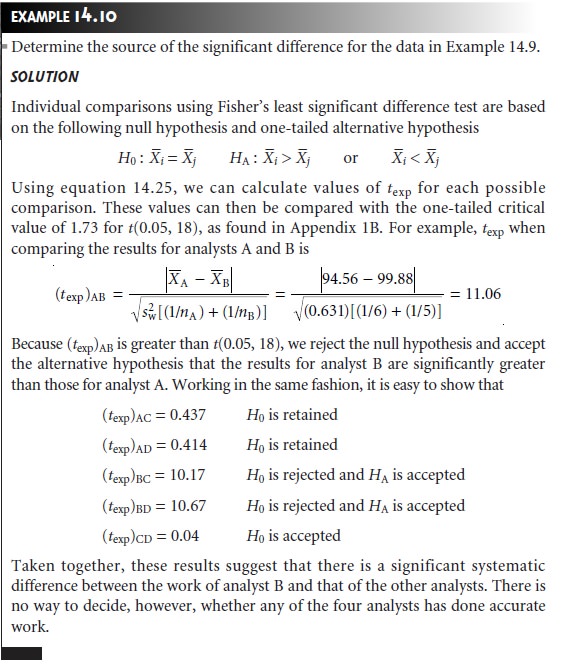Chapter: Modern Analytical Chemistry: Developing a Standard Method
Collaborative Testing and Analysis of Variance
Collaborative Testing and Analysis of Variance
In the two-sample collaborative test, each
analyst performs a single determina- tion on two separate
samples. The resulting
data are reduced
to a set of differ- ences, D, and a set of totals,
T, each characterized by a mean value and a stan- dard deviation. Extracting values for random errors affecting precision and systematic differences between analysts is relatively straightforward for this ex- perimental design.
An alternative approach
for collaborative testing
is to have each analyst
per- form several replicate determinations on a single, common
sample. This approach generates a separate data set for each analyst,
requiring a different statistical treat-
ment to arrive at estimates
for σrand and σsys.
A variety of statistical methods
may be used
to compare three
or more sets
of data. The most
commonly used method
is an analysis of variance (ANOVA). In its simplest form,
a one-way ANOVA
allows the importance of a single
variable, such as the identity of the analyst,
to be determined. The importance of this variable
is evaluated by comparing its variance with the variance
explained by indeterminate sources of error inherent
to the analytical method.
Variance was introduced as one measure of a data set’s spread around its central tendency.
In the context of an analysis of variance, it is useful to
see that variance is simply
a ratio of the sum of squares
for the differences between individual values and their mean, to the degrees of freedom. For example, the vari-
ance, s2, of a data set consisting of n measurements is given as

where Xi is
the value of a single measurement, and X– is the mean. As we will see, the ability to partition the variance into separate terms
for the sum of squares
and the degrees of freedom greatly
simplifies the calculations in a one-way
ANOVA.
Let’s use a simple example
to develop the rationale behind
a one-way ANOVA calculation. The data in Table 14.7
show the results
obtained by several
analysts in de- termining the purity of a single
pharmaceutical preparation of sulfanilamide. Each column in this table
lists the results
obtained by an individual analyst.
For conve- nience, entries
in the table
are represented by the symbol
Xij, where i identifies the an- alyst and j indicates the replicate number;
thus X3,5 is the fifth replicate for the third analyst (and is equal
to 94.24%). The variability in the results
shown in Table
14.7 arises from two sources: indeterminate errors associated with the analytical procedure that are experienced equally by all analysts, and systematic or determinate errors
in- troduced by the analysts.

One way to view the data in Table 14.7 is to treat it as a
single system, charac-terized by a global mean, X–, and a global variance, s2’’ . These parameters are
calcu-
lated using the following equations.


where h is the
total number of samples (in
this case the
number of analysts), ni is the number of replicates for the ith sample
(in this case the ith analyst), and N is the total number of data points in the system.
The global variance
provides a measure of the combined influence of indeterminate and systematic errors.
A second way
to work with
the data in Table 14.7
is to treat the results
for each analyst separately. Because the repeatability for any analyst
is influenced by indeter-
minate errors, the variance, sw2, of the data in each column provides
an estimate of σ2rand. A better
estimate is obtained by pooling the individual variances. The result, rand
|
w |

Finally, the data for each analyst can be reduced to separate
mean values, X–i.
The variance of the individual means about the global mean is called the between- sample variance, sb2, and is calculated as

where ni is the number
of replicates for the ith sample.
The between-sample vari- ance includes contributions from
both random and systematic errors and, therefore,
provides an estimate for both σ2rand and σ2rand.

where n– is approximated as the average number of replicates per analyst.

In a one-way ANOVA of the data in
Table 14.7, the null hypothesis is that no significant differences exist
between the mean values for each analyst. The alterna- tive hypothesis is that
at least one of the means is significantly different. If the null hypothesis is
true, then σ2sys must be zero. Thus, from equations 14.22
and 14.24 both sw2 and sb2 are
predictors of σ2rand and should have similar values. If sb2
is signifi- cantly greater than sw2, then σ2sys
is greater than zero. In this case the alternative hy-pothesis must be
accepted, and a significant difference between the means for the analysts has
been demonstrated. The test statistic is the F-ratio

which is compared with the critical
value F(α, h – 1, N – h). This is a one-tailed signifi- cance test because we
are only interested in whether sb2 is significantly
greater than sw2.
Both sb2 and sw2
are easy to determine for small data sets. For larger data sets, however,
calculating sw2 becomes tedious.* Its calculation is
simplified by taking advantage of the relationship between the sum-of-squares
terms for the global variance, the within-sample variance, and the
between-sample variance. The numerator of equation 14.21, which also is known
as the total sum of squares, SSt, can be split into two terms
SSt = SSw + SSb
where the sum of squares for the variation within the sample, SSw,
is the numerator of equation 14.22, and the sum of squares between the sample,
SSb, is the numera- tor of equation 14.23. Calculating SSt
and SSb gives SSw by difference. Dividing SSw and SSb by
their respective degrees of freedom gives sw2 and sw2.
Table 14.8 summa- rizes all the necessary equations for a one-way ANOVA
calculation. The application of a one-way ANOVA is outlined in Example 14.9.



Once a significant difference has been demonstrated by an analysis
of variance, a modified version of the
t-test, known as Fisher’s least
significant difference, can be used to determine which analyst or analysts are responsible for the difference.
The test statistic for comparing the mean values X–1 and X–2 is the t-test, except that spool is replaced by the square
root of the within-sample vari- ance obtained from an analysis of variance.

This value of texp is compared with the critical
value for t(α, v), where the signifi-
cance level is the same as that used in the ANOVA
calculation, and the degrees of freedom is the same as that for the within-sample variance. Because we are inter-
ested in whether the larger of the two means is significantly greater than the other
mean, the value of t(α, v) is that for a one-tail significance test.

An analysis of variance can be extended
to systems involving more than a single
variable. For example, a two-way
ANOVA can be used in a collaborative study to determine the importance to an analytical method of both the analyst
and the in- strumentation used. The treatment
of multivariable ANOVA is beyond the scope of
this text.
Related Topics